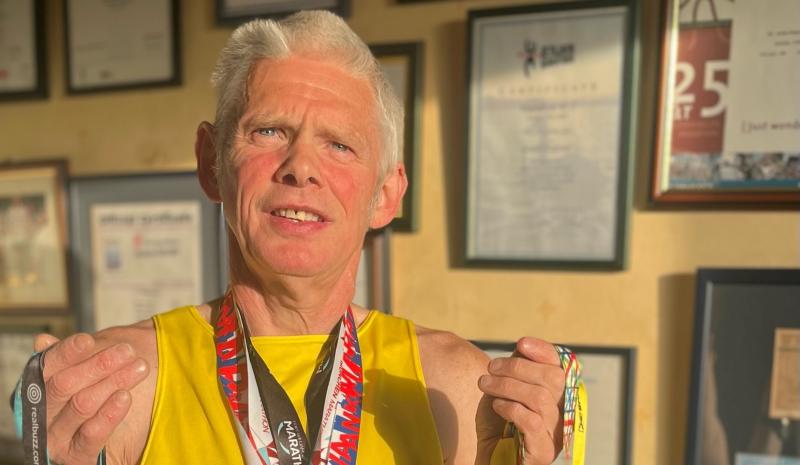Featured
Consumating a thirty-year love affair with Ireland

Lifestyle – Judy Murphy meets a couple who have brought a flavour of the South of France to Galway
Catherine Schreiber first visited Ireland as a teenager with her mother more than 30 years ago. After three weeks travelling around the country on holidays, the French teenager announced “one day, I will live here”.
Separately, and unbeknownst to her, the man who would much later become her husband, had decided the same thing in 1979. That was the year 18-year-old Thierry Schreiber had come to Galway with his friends, “to play music”.
At the time, Irish traditional music was enjoying a huge revival at home and abroad with the likes of the Bothy Band and Planxty blazing a trail on the international folk scene.
“We played their music in France, or tried to,” says Thierry with a laugh. So, it was natural to visit Galway where he and his friends gigged in pubs and on the streets.
Like Catherine, who was 14 when she first visited, he fell in love with the music scene, the countryside and the overall atmosphere on that occasion.
But it’s a long way from visiting regularly to moving here, lock, stock and barrel. Yet, that’s what Catherine and Thierry did just a year ago, selling off their home in the sunny South of France and relocating to Salthill, which may be scenic but isn’t exactly renowned for its sunshine.
Since then, they have drawn on their extensive experience in the hospitality industry to open Taste of France, a quirky and colourful shop on the city’s Cross Street, where they sell everything from boar terrine to chocolate, from olive oil soaps and creams to beautiful linen products from the Basque region of France.
Chatting to them about their business and their relationship with each other and this country, it’s easy to see why they loved Ireland from the get-go. Despite the fact that English is not their first language, they have a wicked sense of humour and laid-back approach to life. Both are really friendly, a trait that they point out is not always associated with their country-people.
Catherine, who has a son from a previous relationship, met Thierry when they were working in Alsace, on the German border.
Having trained in hotel management, she had yearned to work in one of Ireland’s “beautiful hotels and castles”, but hadn’t got around to it. Instead, she worked in various four-star establishments in France and ran the catering for a folk museum complex in Alsace, “something like the Bunratty Folk Park”, except with several restaurants.
It was there, in the early 1990s, that she met Thierry who was a director in the museum, specialising in marketing.
“I was the food and beverage boss, but he was the big, big boss – he had one big more than me,” she says with a laugh.
Love took its time blossoming – at least for Thierry!
“It was nearly six months before he noticed me, but then he opened his eyes,” she recalls as he laughs.
When he did, Catherine told him straight up that they could have no prospects unless he was prepared to live in Ireland in the future.
He recounted his experience in Galway and their romance progressed. They married some years later and have a teenage son, Lucien – Catherine also has a son from a previous relationship.
After Alsace, they settled in the South of France in a city called Millau, on the confluence of the Tarn and Dourbie Rivers. There, they had a successful business running a B&B and five self-catering houses. Thierry worked in a print factory and Catherine, who qualified as a holistic therapist in the early 2000s, had a busy clinic where she practised reflexology and reiki.
It was warm, it was sunny and they were doing nicely but their yearning for Ireland had not abated.
So they sold their house and her clinic while Thierry left his job: “all we had built up in a life,” observes Catherine. But they did it willingly to fulfil their dream.
Lucien moved with them, and while he was initially apprehensive about leaving his French friends behind, he has settled in well.
“He’s a first-year engineering student in NUIG and is on the national Irish team for kayaking freestyle,” says his mother.
Lucien had been on the national team in France, but felt it was sensible to change allegiance when he moved here. So, he competed in the necessary heats, winning his place on the national team.
For more, read this week’s Connacht Tribune.
Connacht Tribune
West has lower cancer survival rates than rest

Significant state investment is required to address ‘shocking’ inequalities that leave cancer patients in the West at greater risk of succumbing to the disease.
A meeting of Regional Health Forum West heard that survival rates for breast, lung and colorectal cancers than the national average, and with the most deprived quintile of the population, the West’s residents faced poorer outcomes from a cancer diagnosis.
For breast cancer patients, the five-year survival rate was 80% in the West versus 85% nationally; for lung cancer patients it was 16.7% in the west against a 19.5% national survival rate; and in the West’s colorectal cancer patients, there was a 62.6% survival rate where the national average was 63.1%.
These startling statistics were provided in answer to a question from Ballinasloe-based Cllr Evelyn Parsons (Ind) who said it was yet another reminder that cancer treatment infrastructure in the West was in dire need of improvement.
“The situation is pretty stark. In the Western Regional Health Forum area, we have the highest incidence of deprivation and the highest health inequalities because of that – we have the highest incidences of cancer nationally because of that,” said Cllr Parsons, who is also a general practitioner.
In details provided by CEO of Saolta Health Care Group, which operates Galway’s hospitals, it was stated that a number of factors were impacting on patient outcomes.
Get the full story in this week’s Connacht Tribune, on sale in shops now, or you can download the digital edition from www.connachttribune.ie. You can also download our Connacht Tribune App from Apple’s App Store or get the Android Version from Google Play.
Connacht Tribune
Marathon Man plans to call a halt – but not before he hits 160 races

On the eve of completing his 150th marathon, an odyssey that has taken him across 53 countries, Loughrea’s Marathon Man has announced that he is planning to hang up his running shoes.
But not before Jarlath Fitzgerald completes another ten races, making it 160 marathons on the occasion of his 60th birthday.
“I want to draw the line in 2026. I turn 57 in October and when I reach 60 it’s the finishing line. The longer races are taking it out of me. I did 20 miles there two weeks ago and didn’t feel good. It’s getting harder,” he reveals.
“I’ve arthritis in both hips and there’s wear and tear in the knees.”
We speak as he is about to head out for a run before his shift in Supervalu Loughrea. Despite his physical complaints, he still clocks up 30 miles every second week and generally runs four days a week.
Jarlath receives injections to his left hip to keep the pain at bay while running on the road.
To give his joints a break, during the winter he runs cross country and often does a five-mile trek around Kylebrack Wood.
He is planning on running his 150th marathon in Cork on June 4, where a group of 20 made up of work colleagues, friends and running mates from Loughrea Athletics Club will join him.
Some are doing the 10k, others are doing the half marathon, but all will be there on the finishing line to cheer him on in the phenomenal achievement.
Get the full story in this week’s Connacht Tribune, on sale in shops now, or you can download the digital edition from www.connachttribune.ie. You can also download our Connacht Tribune App from Apple’s App Store or get the Android Version from Google Play.
CITY TRIBUNE
Galway ‘masterplan’ needed to tackle housing and transport crises

From the Galway City Tribune – An impassioned plea for a ‘masterplan’ that would guide Galway City into the future has been made in the Dáil. Galway West TD Catherine Connolly stated this week that there needed to be an all-inclusive approach with “vision and leadership” in order to build a sustainable city.
Deputy Connolly spoke at length at the crisis surrounding traffic and housing in Galway city and said that not all of the blame could be laid at the door of the local authority.
She said that her preference would be the provision of light rail as the main form of public transport, but that this would have to be driven by the government.
“I sat on the local council for 17 years and despaired at all of the solutions going down one road, metaphorically and literally. In 2005 we put Park & Ride into the development plan, but that has not been rolled out. A 2016 transport strategy was outdated at the time and still has not been updated.
“Due to the housing crisis in the city, a task force was set up in 2019. Not a single report or analysis has been published on the cause of the crisis,” added Deputy Connolly.
She then referred to a report from the Land Development Agency (LDA) that identified lands suitable for the provision of housing. But she said that two-thirds of these had significant problems and a large portion was in Merlin Park University Hospital which, she said, would never have housing built on it.
In response, Minister Simon Harris spoke of the continuing job investment in the city and also in higher education, which is his portfolio.
But turning his attention to traffic congestion, he accepted that there were “real issues” when it came to transport, mobility and accessibility around Galway.
“We share the view that we need a Park & Ride facility and I understand there are also Bus Connects plans.
“I also suggest that the City Council reflect on her comments. I am proud to be in a Government that is providing unparalleled levels of investment to local authorities and unparalleled opportunities for local authorities to draw down,” he said.
Then Minister Harris referred to the controversial Galway City Outer Ring Road which he said was “struck down by An Bord Pleanála”, despite a lot of energy having been put into that project.
However, Deputy Connolly picked up on this and pointed out that An Bord Pleanála did not say ‘No’ to the ring road.
“The High Court said ‘No’ to the ring road because An Bord Pleanála acknowledged it failed utterly to consider climate change and our climate change obligations.
“That tells us something about An Bord Pleanála and the management that submitted such a plan.”
In the end, Minister Harris agreed that there needed to be a masterplan for Galway City.
“I suggest it is for the local authority to come up with a vision and then work with the Government to try to fund and implement that.”












